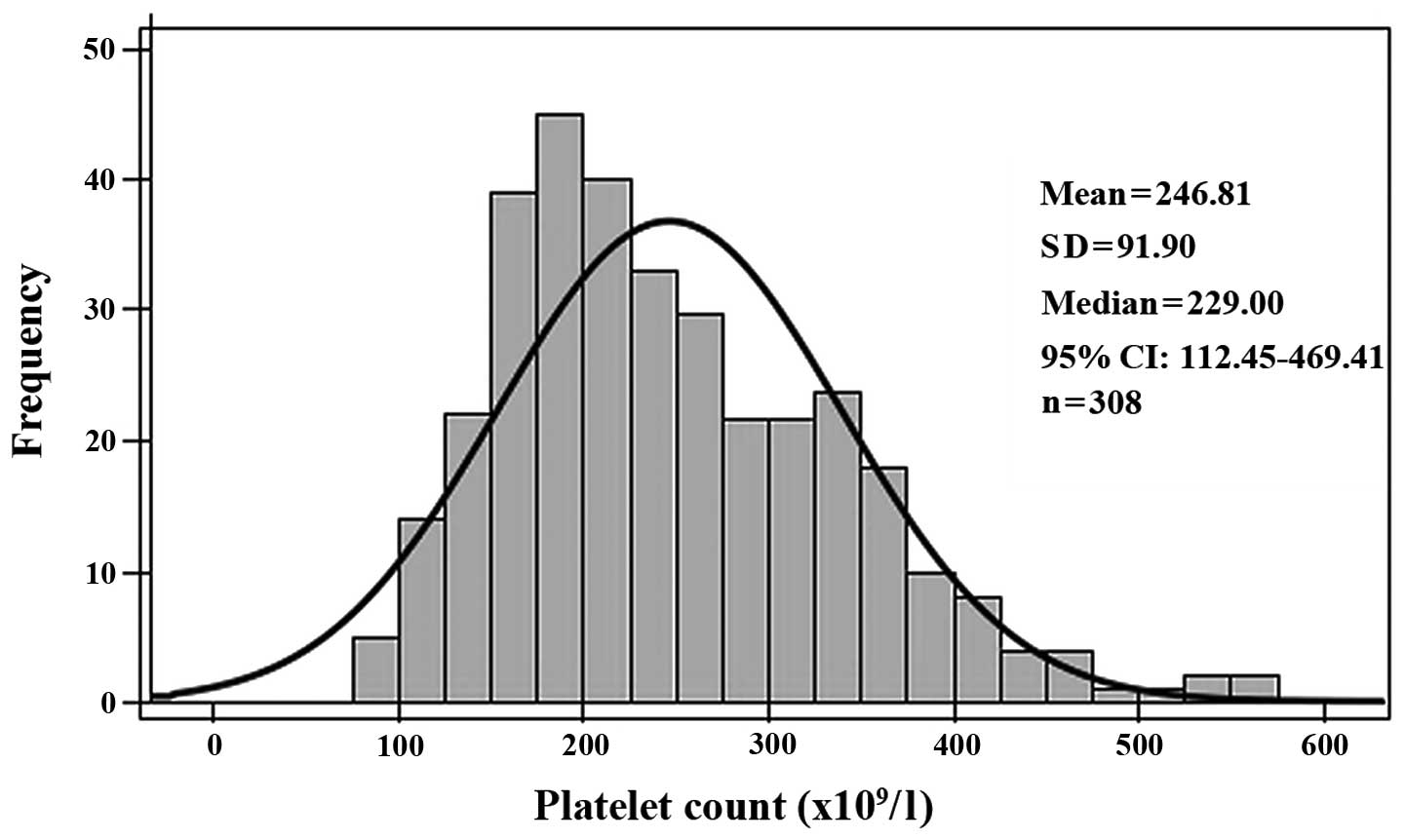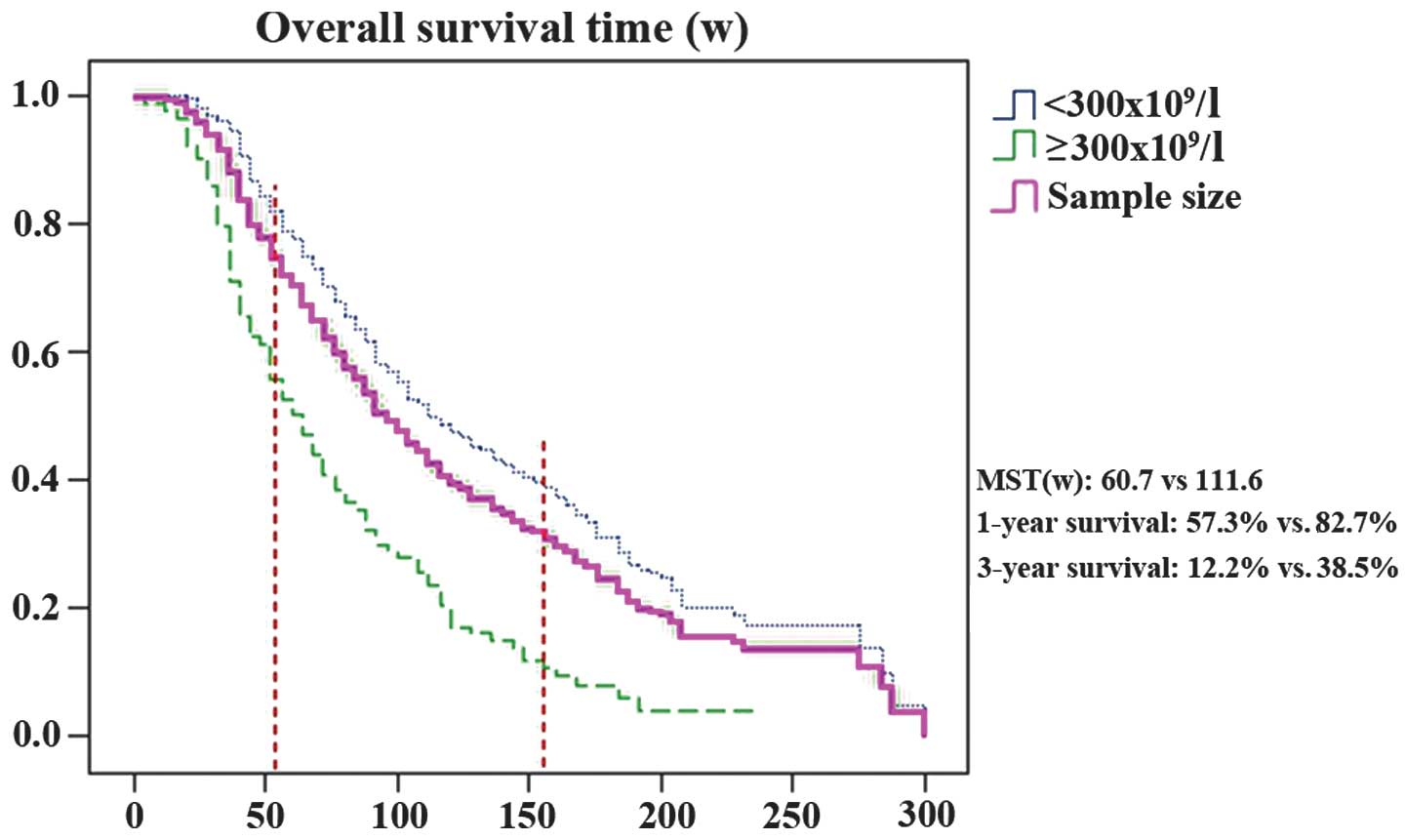|
1
|
Pedersen LM and Milman N: Prognostic
significance of thrombocytosis in patients with primary lung
cancer. Eur Respir J. 9:1826–1830. 1996. View Article : Google Scholar : PubMed/NCBI
|
|
2
|
Aoe K, Hiraki A, Ueoka H, et al:
Thrombocytosis as a useful prognostic indicator in patients with
lung cancer. Respiration. 71:170–173. 2004. View Article : Google Scholar : PubMed/NCBI
|
|
3
|
Lehmann J, Retz M, Nürnberg N, et al: The
superior prognostic value of humoral factors compared with
molecular proliferation markers in renal cell carcinoma. Cancer.
101:1552–1562. 2004. View Article : Google Scholar : PubMed/NCBI
|
|
4
|
Shimada H, Oohira G, Okazumi S, et al:
Thrombocytosis associated with poor prognosis in patients with
esophageal carcinoma. J Am Coll Surg. 198:737–741. 2004. View Article : Google Scholar : PubMed/NCBI
|
|
5
|
Suzuki K, Aiura K, Kitagou M, et al:
Platelets counts closely correlate with the disease-free survival
interval of pancreatic cancer patients. Hepatogastroenterology.
51:847–853. 2004.PubMed/NCBI
|
|
6
|
Brockmann MA, Giese A, Mueller K, et al:
Preoperative thrombocytosis predicts poor survival in patients with
glioblastoma. Neuro Oncol. 9:335–342. 2007. View Article : Google Scholar : PubMed/NCBI
|
|
7
|
Iwasaki A, Hamanaka W, Harnada T, et al:
Significance of platelet counts in patients who underwent surgical
treatment for lung metastasis. Int Surg. 92:103–109.
2007.PubMed/NCBI
|
|
8
|
Tomita M, Shimizu T, Hara M, et al:
Prognostic impact of thrombocytosis in resectable non-small cell
lung cancer. Interact Cardiovasc Thorac Surg. 7:613–615. 2008.
View Article : Google Scholar : PubMed/NCBI
|
|
9
|
Kaushansky K: Thrombopoietin: the primary
regulator of platelet production. Blood. 86:419–431.
1995.PubMed/NCBI
|
|
10
|
Kaushansky K: Thrombopoietin the primary
regulator of platelet production. Trends Endocrinol Metab. 8:45–50.
1997. View Article : Google Scholar : PubMed/NCBI
|
|
11
|
Schafer AI: Thrombocytosis. New Engl J
Med. 350:1211–1219. 2004. View Article : Google Scholar : PubMed/NCBI
|
|
12
|
Slayton WB, Wainman DA, Li XM, et al:
Developmental differences in megakaryocyte maturation are
determined by the microenvironment. Stem cells. 23:1400–1408. 2005.
View Article : Google Scholar : PubMed/NCBI
|
|
13
|
Sungaran R, Chisholm OT, Markovic B, et
al: The role of platelet alpha-granular proteins in the regulation
of thrombopoietin messenger RNA expression in human bone marrow
stromal cells. Blood. 95:3094–3101. 2000.PubMed/NCBI
|
|
14
|
Canonico S, Sciaudone G, Santoriello A, et
al: Blood coagulation changes in patients with post-splenectomy
persistent thrombocytosis. Chir Ital. 53:537–542. 2001.(In
Italian). PubMed/NCBI
|
|
15
|
Jurasz P, Alonso-Escolano D and Radomski
MW: Platelet - cancer interactions: mechanisms and pharmacology of
tumour cell-induced platelet aggregation. Br J Pharmacol.
143:819–826. 2004. View Article : Google Scholar : PubMed/NCBI
|
|
16
|
Morimoto K, Satoh-Yamaguchi K, Hamaguchi
A, et al: Interaction of cancer cells with platelets mediated by
Necl-5/poliovirus receptor enhances cancer cell metastasis to the
lungs. Oncogene. 27:264–273. 2008. View Article : Google Scholar
|
|
17
|
Sierko E and Wojtukiewicz MZ: Platelets
and angiogenesis in malignancy. Semin Thromb Hemost. 30:95–108.
2004. View Article : Google Scholar : PubMed/NCBI
|
|
18
|
Bick RL: Cancer-associated thrombosis. New
Engl J Med. 349:109–111. 2003. View Article : Google Scholar : PubMed/NCBI
|
|
19
|
Oken MM, Creech RH, Tormey DC, et al:
Toxicity and response criteria of the Eastern Cooperative Oncology
Group. Am J Clin Oncol. 5:649–655. 1982. View Article : Google Scholar : PubMed/NCBI
|
|
20
|
Sobin LH and Wittekind C: Rules for
Classification. International Union Against Cancer (UICC) TNM
Classification of Malignant Tumours. 6th edition. Wiley-Liss; New
York, NY: pp. 99–103. 2002
|
|
21
|
Zeng SM, Murray JC, Widness JA, Strauss RG
and Yankowitz J: Association of single nucleotide polymorphisms in
the thrombopoietin-receptor gene, but not the thrombopoietin gene,
with differences in platelet count. Am J Hematol. 77:12–21. 2004.
View Article : Google Scholar : PubMed/NCBI
|
|
22
|
Sawabata N, Maeda H, Yokota S, et al:
Postoperative serum carcinoembryonic antigen levels in patients
with pathologic stage IA nonsmall cell lung carcinoma: subnormal
levels as an indicator of favorable prognosis. Cancer. 101:803–809.
2004. View Article : Google Scholar : PubMed/NCBI
|
|
23
|
Göğüş C, Baltaci S, Filiz E, Elhan A and
Bedük Y: Significance of thrombocytosis for determining prognosis
in patients with localized renal cell carcinoma. Urology.
63:447–450. 2004. View Article : Google Scholar
|
|
24
|
Ikeda M, Furukawa H, Imamura H, et al:
Poor prognosis associated with thrombocytosis in patients with
gastric cancer. Ann Surg Oncol. 9:287–291. 2002. View Article : Google Scholar : PubMed/NCBI
|
|
25
|
Hwang SG, Kim KM, Cheong JH, et al: Impact
of pretreatment thrombocytosis on blood-borne metastasis and
prognosis of gastric cancer. Eur J Surg Oncol. 38:562–567. 2012.
View Article : Google Scholar : PubMed/NCBI
|
|
26
|
Connor DE and Joseph JE: Cyclic
thrombocytopenia associated with marked rebound thrombocytosis and
fluctuating levels of endogenous thrombopoietin and reticulated
platelets: A case report. Am J Hematol. 87:120–122. 2012.
View Article : Google Scholar
|
|
27
|
Onal H, Adal E, Ersen A, Onal Z and
Keskindemirci G: Miliaria rubra and thrombocytosis in
pseudohypoaldosteronism: case report. Platelets. 23:645–647. 2012.
View Article : Google Scholar
|
|
28
|
Li AJ and Karlan BY: Androgen mediation of
thrombocytosis in epithelial ovarian cancer biology. Clin Cancer
Res. 11:8015–8018. 2005. View Article : Google Scholar : PubMed/NCBI
|
|
29
|
Chen SC, Chang HK, Lin YC, et al:
Prognosis of breast cancer after supraclavicular lymph node
metastasis: not a distant metastasis. Ann Surg Oncol. 13:1457–1465.
2006. View Article : Google Scholar : PubMed/NCBI
|
|
30
|
Chen HC, Wang CY and Wang CS: Marked
thrombocytosis during treatment with ceftazidime for pulmonary
infection. Pharm World Sci. 30:70–72. 2008. View Article : Google Scholar
|
|
31
|
Nanavati A, Patel N and Burke J:
Thrombocytosis and coronary occlusion. JACC Cardiovasc Interv.
5:e18–e19. 2012. View Article : Google Scholar : PubMed/NCBI
|
|
32
|
Roodman GD: Mechanisms of bone metastasis.
New Engl J Med. 350:1655–1664. 2004. View Article : Google Scholar : PubMed/NCBI
|












